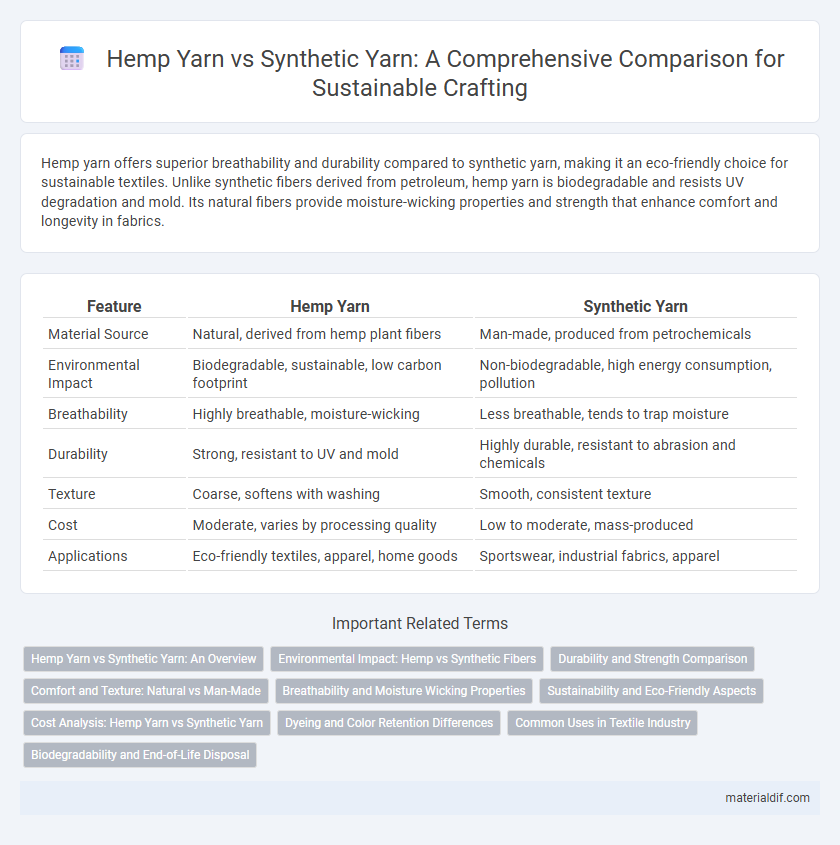Hemp yarn offers superior breathability and durability compared to synthetic yarn, making it an eco-friendly choice for sustainable textiles. Unlike synthetic fibers derived from petroleum, hemp yarn is biodegradable and resists UV degradation and mold. Its natural fibers provide moisture-wicking properties and strength that enhance comfort and longevity in fabrics.
Table of Comparison
| Feature | Hemp Yarn | Synthetic Yarn |
|---|---|---|
| Material Source | Natural, derived from hemp plant fibers | Man-made, produced from petrochemicals |
| Environmental Impact | Biodegradable, sustainable, low carbon footprint | Non-biodegradable, high energy consumption, pollution |
| Breathability | Highly breathable, moisture-wicking | Less breathable, tends to trap moisture |
| Durability | Strong, resistant to UV and mold | Highly durable, resistant to abrasion and chemicals |
| Texture | Coarse, softens with washing | Smooth, consistent texture |
| Cost | Moderate, varies by processing quality | Low to moderate, mass-produced |
| Applications | Eco-friendly textiles, apparel, home goods | Sportswear, industrial fabrics, apparel |
Hemp Yarn vs Synthetic Yarn: An Overview
Hemp yarn outperforms synthetic yarn in terms of sustainability, as it is biodegradable and requires fewer pesticides during cultivation. Its natural fibers offer superior breathability and moisture-wicking properties compared to synthetic yarns, which are petroleum-based and less eco-friendly. Hemp yarn also provides enhanced durability and UV resistance, making it a preferred choice for environmentally conscious textile production.
Environmental Impact: Hemp vs Synthetic Fibers
Hemp yarn has a significantly lower environmental impact compared to synthetic yarn, as it is biodegradable and requires less water and pesticides during cultivation. Synthetic fibers are petroleum-based, contributing to microplastic pollution and non-renewable resource depletion. Hemp's natural fibers also support sustainable agriculture by improving soil health and reducing carbon emissions.
Durability and Strength Comparison
Hemp yarn exhibits superior durability and tensile strength compared to most synthetic yarns due to its natural fiber composition, which resists wear and tear effectively. Its robust lignin and cellulose structure provide enhanced abrasion resistance, making hemp yarn ideal for heavy-duty applications and long-lasting textile products. Synthetic yarns, although often engineered for specific strengths, tend to degrade faster under UV exposure and repeated stress, highlighting hemp's advantage in strength retention and eco-friendly resilience.
Comfort and Texture: Natural vs Man-Made
Hemp yarn offers superior breathability and moisture-wicking properties compared to synthetic yarn, resulting in a more comfortable and cooler fabric especially in warm climates. The natural fibers of hemp provide a soft yet slightly coarse texture that softens with wear and washing, enhancing comfort over time. Synthetic yarns often feel smoother initially but can trap heat and moisture, potentially causing discomfort during extended use.
Breathability and Moisture Wicking Properties
Hemp yarn offers superior breathability compared to synthetic yarns due to its natural hollow fibers that allow air circulation and moisture evaporation, keeping the fabric cool and dry. The moisture-wicking properties of hemp yarn effectively draw sweat away from the skin, enhancing comfort and reducing odor buildup in activewear or warm conditions. In contrast, synthetic yarns often trap heat and moisture, leading to dampness and discomfort during prolonged wear.
Sustainability and Eco-Friendly Aspects
Hemp yarn is significantly more sustainable than synthetic yarn due to its biodegradable nature and minimal environmental impact during cultivation, which requires less water and no pesticides. Unlike synthetic yarns derived from petroleum-based products that contribute to microplastic pollution, hemp yarn decomposes naturally without releasing harmful toxins. The renewable qualities and carbon sequestration ability of hemp plants make hemp yarn a crucial eco-friendly alternative in the textile industry.
Cost Analysis: Hemp Yarn vs Synthetic Yarn
Hemp yarn generally has a higher initial cost compared to synthetic yarn due to eco-friendly cultivation and labor-intensive processing methods. Synthetic yarn is more affordable, benefiting from mass production and lower raw material expenses. Over time, hemp yarn offers greater cost-efficiency through durability and biodegradability, reducing replacement and environmental costs.
Dyeing and Color Retention Differences
Hemp yarn exhibits superior dye absorption due to its natural cellulose fibers, allowing for vibrant, long-lasting colors compared to synthetic yarns, which often require specialized dyes to adhere effectively. The porous structure of hemp enhances color retention even after multiple washes, whereas synthetic yarns tend to fade or discolor more rapidly under similar conditions. This natural affinity for dye makes hemp yarn an eco-friendly and durable choice for textiles demanding consistent coloration.
Common Uses in Textile Industry
Hemp yarn is widely used in the textile industry for eco-friendly clothing, home textiles, and durable accessories due to its natural strength and breathability. Synthetic yarns, such as polyester and nylon, dominate in high-performance sportswear, industrial fabrics, and affordable mass-produced garments because of their elasticity and moisture-wicking properties. The contrast in common uses highlights hemp's sustainability advantage and synthetics' versatility in specialized textile applications.
Biodegradability and End-of-Life Disposal
Hemp yarn demonstrates superior biodegradability compared to synthetic yarn, breaking down naturally within months without releasing harmful microplastics into the environment. Unlike synthetic yarn, which is petroleum-based and can take hundreds of years to decompose, hemp yarn supports sustainable end-of-life disposal through composting or soil integration. This natural fiber reduces landfill burden and minimizes ecological toxicity, making it an environmentally responsible choice in textile production.
hemp yarn vs synthetic yarn Infographic

 materialdif.com
materialdif.com